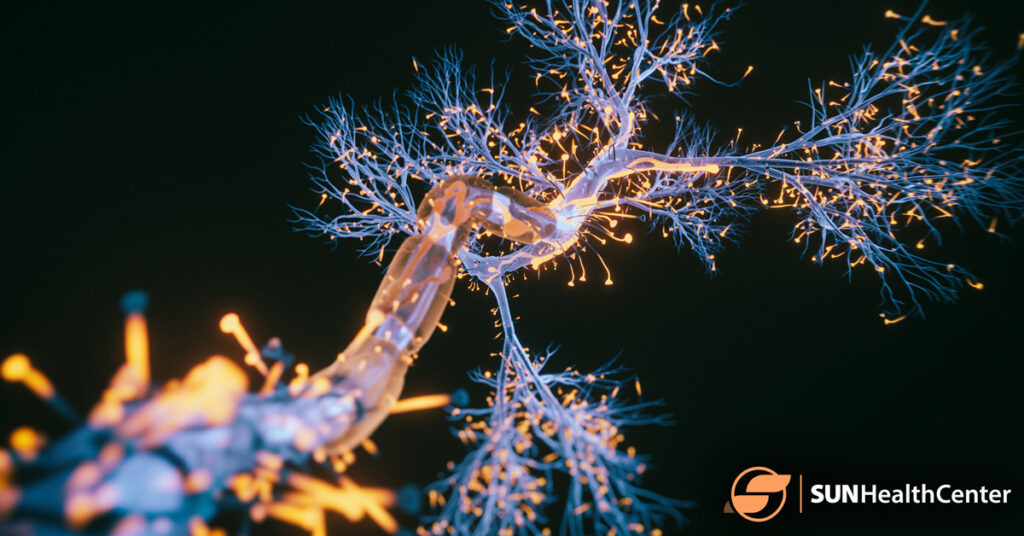
In the science of substance use disorders and other forms of addiction, the brain plays an important role. Put simply, the effects of addiction on the brain’s prefrontal cortex influence the way addicted individuals react to stress. Over 20 million Americans aged 12 or older suffer from these effects, whose alteration of behavioral control can be amplified in a variety of ways by other factors such as environment and genetics.
Recent advances in neuroscience, however, offer new and noninvasive ways to treat these disorders. One of the most promising is transcranial photobiomodulation, also known as tPBM.
Exploring the Cutting Edge of Neuroscience: ERP and Photobiomodulation
The use of low-intensity red or near-infrared light in various therapeutic treatments has been a rising phenomenon in medicine for decades. In simple terms, “photobiomodulation” (PBM) is the use of light to influence the body’s cells. Its purpose is to trigger the body’s capacity to repair itself, reduce symptoms like inflammation and pain and promote healing.
The penetration of light into cells’ mitochondria produces a photochemical reaction that enhances the production of adenosine triphosphate (ATP), a compound that powers cellular function. When cellular function is enhanced, the energy can be deployed to address a wide variety of disorders.
With the aid of modern precision instruments, the possible applications of PBM are rapidly expanding. Brain photomodulation has shown particular potential, especially with the increased ability of neuroscience to track outcomes by the use of event-related potentials or ERPs.
Event-Related Potentials (ERPs): Unveiling the Brain’s Electrical Signals
PBM can be applied to the brain just as it can to other parts of the body. An important part of using this technology effectively is to be able to monitor and model how the brain works. Cognitive neurophysiology focuses on event-related potentials — tracking the various kinds of electrical activity in a brain as it reacts to triggers — as a primary tool for this purpose.
Our brain responds to events every day. Say an “event” is sensory input — a particular smell, taste or image. To respond to it, the brain may interact with our sense of cognition and motor control. An ERP is the measure of this response.
Electroencephalography (EEG) is the technology used to study ERPs, allowing the noninvasive monitoring of various responses to stimuli. The technology has a near century-old history but has adapted to the modern era with the rise of widespread, inexpensive computing power that makes it easier to analyze complicated neural phenomena.
The study of ERPs makes it possible to decipher how human perception and behavior relate to the brain’s electrical signals. In turn, we can track how those signals change over time in connection with treatments like PBM. Those advancements have set the stage for a specific form of PBM treatment in which light photons are transmitted through the skull to directly promote the healing of brain tissue, called “transcranial” PBM.
Harnessing Light for Brain Health: Transcranial Photobiomodulation’s Potential
When applied directly to the brain, photomodulation technology has already proven to be effective in numerous different fields. A few applications include the treatment of traumatic brain injuries, strokes and common brain disorders, including Alzheimer’s and Parkinson’s disease. The treatment has also shown promise in enhancing visual working memory, alleviating depression and treating the chronic fatigue and brain fog associated with “Long COVID,” a chronic condition onset after someone has contracted COVID-19.
Additionally, experts believe there’s hope for those in recovery for addiction. Opioid use disorder, or OUD, has proven increasingly destructive nationally and globally. Cases of OUD have risen dramatically since the turn of the century, but tPBM treatment could treat these addictions by going straight to the source.
A recent study exploring the idea of using tPBM to treat opioid use disorder measured the responses of opioid cravings during a three-course period of tPBM treatment. Scientists observed an apparent 71% reduction in cravings among participants who received tPBM. A control group receiving a placebo treatment also registered decreased cravings, but at a far lower rate. The overall result suggests tPBM could have a future as a safe, effective way of treating the neurological roots of addictive behaviors.
Applications, Research and Future Possibilities in ERP and Photobiomodulation
While PBM is a relatively young field, it’s also seen the publication of thousands of articles in recent years. Many of these studies focus on its possible uses for the treatment of brain injuries, strokes, dementia, major depressive disorder and diseases of the central nervous system. In all these cases, PBM has demonstrable therapeutic power and offers the potential of a noninvasive and safe approach to treatment that avoids adverse side effects.
However, like plenty of emerging fields, many of the findings on this kind of low-light therapy are still preliminary. More studies are still needed to translate promising study results into optimized, widely available treatments. This research, together with longer-term studies and larger sample sizes, is on track to provide a more solid scientific foundation that could lead to PBM becoming a reputable treatment option in the medical world.
What’s true for PBM is also true for transcranial photobiomodulation. The application of tPBM to substance use disorders, in particular, is still in very early stages. However, there are promising signs in the understood connection between addiction and the brain, as well as the impact of tPBM on opioid cravings. With advancements in technology and neurology, scientists will be able to study ERPs in increasing detail, fine-tuning the power of tPBM to address the root of the problem in people who live with addiction.
Advanced Addiction Treatments at Sun Health Center
If you’re struggling with a substance use disorder, the compassionate and knowledgeable team at Sun Health Center is here to help. We offer individualized care and stay up to date with the most advanced therapeutic techniques available. Contact us today to begin your recovery journey.
